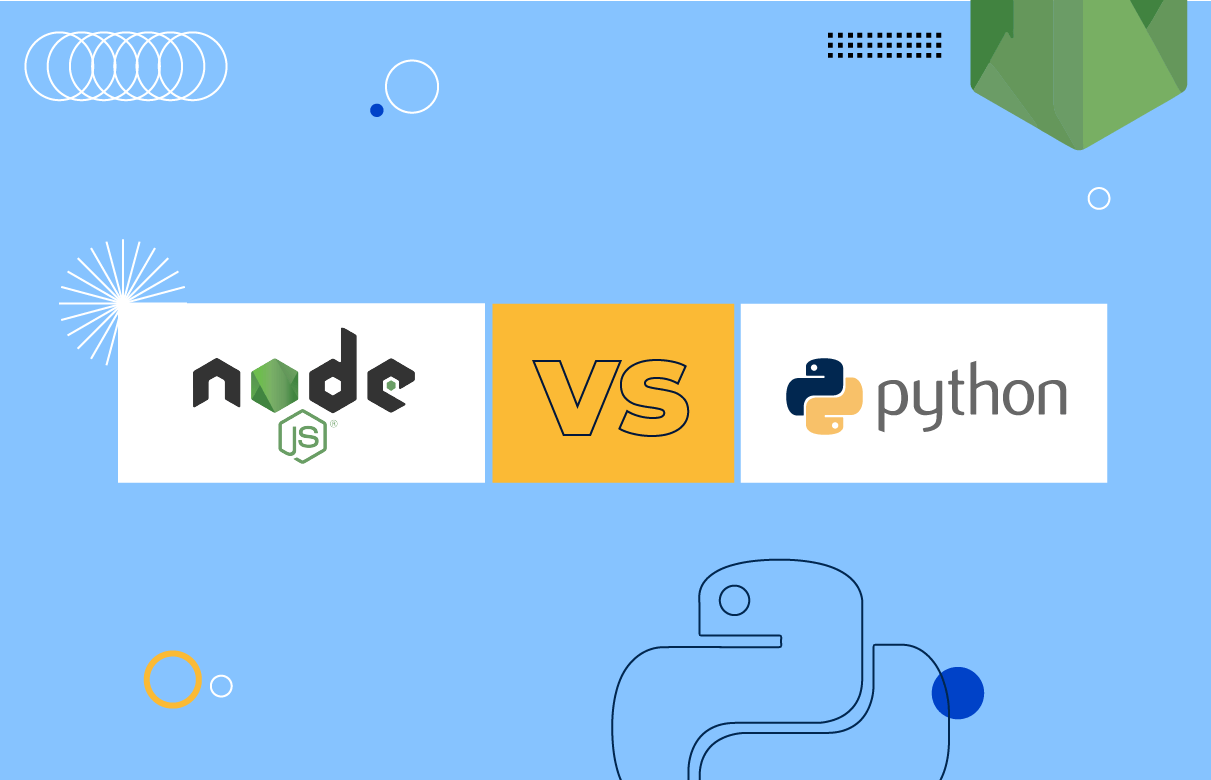Node.js is a popular JavaScript runtime built on Chrome’s V8 engine, which allows developers to build scalable and high-performance applications using JavaScript. Among the key advantages of Node.js is its event loop – a mechanism that enables it to handle large numbers of concurrent connections and helps build real-time web applications.
In this article, we explore the Node.js event loop in detail. We analyze all three of its stages, examine common problems and solutions, as well as list the differences between Node.js and browser event loops. Read on to discover how Node.js loop can revolutionize your web applications.
Develop your custom software with SaM Solutions’ engineers, skilled in the latest tech and well-versed in multiple industries.
The Benefits of Asynchronous Events in Node.js
The event loop is the mechanism used by Node.js to handle I/O operations asynchronously. But what exactly does that mean?
In traditional server-side programming (for instance, with PHP and Java), each client request is handled by a dedicated thread or process in a specific order, which can quickly become inefficient when dealing with a large number of concurrent connections. After all, each connection requires its own dedicated resources.
With Node.js, however, the event-driven architecture allows the server to handle multiple client requests without blocking any of them. When a client request arrives, it is added to the event loop and processed asynchronously. This means that the server can continue to handle other requests while waiting for I/O operations to complete, improving overall efficiency and reducing the likelihood of bottlenecks.
In addition to improved performance, asynchronous event handling also enables the development of real-time web applications that require frequent updates and immediate responses to user input. When powered by Node.js, an application can handle a large number of concurrent connections and deliver real-time updates to users.
How Event Loop Works in Node.js
The Node.js event loop is a critical component of the platform’s architecture, which continuously monitors the Node.js runtime for all events and executes the corresponding callback functions. The loop in Node.js consists of several stages (or phases):
- Timers – This phase of the event loop executes callbacks scheduled by setTimeout() and setInterval().
- Pending callbacks – Here, any pending timers or I/O operations ready to execute are checked. If there are no pending operations, the loop moves to the next stage.
- Poll – This part of the event loop retrieves new I/O events and executes almost all of the I/O-related callbacks, except for the ones scheduled by timers, close callbacks, and setImmediate().
- Check – setImmediate() callbacks are executed at this stage.
- Close callbacks – Finally, the loop executes close callbacks.
The event loop continues to process events until there are no more of them in the queue, and then it waits for new events. It’s important to note that since the mechanism processes microtasks (such as Promise callbacks) before macrotasks (such as I/O callbacks), it does not follow the common first-in, first-out (FIFO) order.
Benefits of Node.js Event Loop
The Node.js event loop provides a powerful and flexible foundation for building modern, high-performance applications, and has become a go-to technology for many developers and organizations. The common benefits of the mechanism include:
Improved performance and scalability
Node.js’s event loop enables non-blocking I/O operations, allowing the server to handle multiple client requests and handle a large number of concurrent connections. This approach improves overall efficiency and reduces the likelihood of bottlenecks, making Node.js an excellent choice for high-performance, scalable web applications.
Real-time web applications
With Node.js’s event loop, developers can create real-time web applications that require immediate responses to user input. Chat applications, multiplayer games, and other real-time applications can all benefit from Node.js’s ability to handle thousands of connections simultaneously.
Cross-platform development
Node.js’s event loop makes it easy to develop cross-platform applications because it provides a consistent, non-blocking I/O model across different platforms. This means that developers can write code that works the same way on different operating systems (Windows, Linux, and macOS) without having to worry about the differences in how I/O operations are handled. Such an approach simplifies the development process and reduces development costs, making Node.js an attractive option for startups and small businesses.
Differences Between the Event Loop in Node.js vs. in Browser
The event loop is a crucial part of the JavaScript runtime environment and is responsible for handling all the I/O operations both in Node.js and the browser. However, there are some significant differences between how the loop works in Node.js and the browser.
- The event loop in a browser is designed to handle UI events, such as mouse clicks and keyboard inputs. In Node.js, it is designed to handle I/O operations, such as reading and writing files or network requests.
- The loop in a browser is typically single-threaded, which means that all events are processed on a single thread. In Node.js, it’s able to handle multiple threads, allowing for more efficient processing of I/O operations.
- Node.js provides a set of built-in modules, such as the ‘fs’ module for file system operations and the ‘http’ module for creating web servers. These are not available in a browser environment.
- The loop in a browser is tightly coupled to the rendering engine. The loop in Node.js is decoupled from the underlying operating system, allowing for more flexibility in handling I/O operations.
Common Problems and Solutions in the Node.js Event Loop
The event loop in Node.js provides several benefits, but some common problems can arise when working with it. Here are some of the most common problems and their solutions, suggested by SaM Solutions experts:
Blocking the loop
If a part of the script blocks the loop, the application may become unresponsive, which can negatively impact the user experience.
Tip from SaM Solutions: Make sure that all long-running operations are executed asynchronously or use worker threads to run the blocking code in a separate thread.
Too many listeners
If too many listeners are attached to a single event, it can cause performance issues and slow down the application.
Tip from SaM Solutions: Use the setMaxListeners() method to set a maximum limit on the number of listeners or use event emitter libraries like EventEmitter2, which can handle a large number of listeners efficiently.
Unhandled exceptions
If an unhandled exception is thrown in the event loop, the program will crash.
Tip from SaM Solutions: Use a ‘try…catch’ statement to handle errors and prevent them from crashing the application.
Callback hell
Asynchronous programming with callbacks can sometimes lead to nested and complex code structures, commonly known as “callback hell.”
Tip from SaM Solutions: Use promises or async/await syntax to write cleaner and more manageable asynchronous code.
Memory leaks
If the application creates too many objects that are not properly cleaned up, it can lead to memory leaks and ultimately cause the application to crash.
Tip from SaM Solutions: Use tools like Node.js’s built-in heap profiling to identify memory leaks and fix them.
Conclusion
The event loop in Node.js is a powerful mechanism that enables developers to build scalable and high-performance applications using JavaScript. With its ability to handle large numbers of concurrent connections and real-time web applications, Node.js has become a popular choice for building modern web applications.
While it provides several benefits, it’s important to be aware of the common problems and solutions to ensure optimal performance and scalability. By following best practices and using asynchronous functions, developers can leverage the event loop in Node.js to build fast and responsive applications.




























 5 Reasons Why Your Business Needs a Mobile eCommerce Application
5 Reasons Why Your Business Needs a Mobile eCommerce Application Using Salesforce to Improve Your Sales Pipeline: Five Tips
Using Salesforce to Improve Your Sales Pipeline: Five Tips Cross-Platform Mobile Development: Five Best Frameworks
Cross-Platform Mobile Development: Five Best Frameworks How to Develop Custom Accounting Software
How to Develop Custom Accounting Software 10 Best Web Development Frameworks in 2024
10 Best Web Development Frameworks in 2024









![[Tech Talk] What Developers Should Know About SQL Optimization, Part 1: Fundamentals](https://www.sam-solutions.com/blog/wp-content/uploads/fly-images/30279/SQL-video-cover-370x238.webp)






 Top 30 Ecommerce Tools to Elevate Your Business in 2024
Top 30 Ecommerce Tools to Elevate Your Business in 2024 5 Best Tools to Improve Embedded Software Testing
5 Best Tools to Improve Embedded Software Testing Why React and Node.js Are the Top Technologies for Creating High-Performance Web Apps in 2024
Why React and Node.js Are the Top Technologies for Creating High-Performance Web Apps in 2024 10 Best IoT Platforms for 2024
10 Best IoT Platforms for 2024
The event loop is just one of the many reasons why I love working with Node.js. This article is a great reminder of its importance.
Node.js’s event loop may seem complex at first, but this article does a great job of simplifying it.
Node.js’s event loop is what makes it so powerful for building scalable applications. This article explains it well.
I never fully understood the event loop in Node.js until I read this article. Very informative!
Great article! It’s amazing how Node.js utilizes the event loop to handle non-blocking I/O operations efficiently. Thanks for the tips on solving issues!